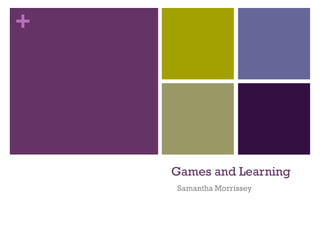3.2 Presentation - Games & Learning
- 1. + Games and Learning Samantha Morrissey
- 2. + Purpose ’ü« Games in the classroom is more than just making a lesson ŌĆ£more fun.ŌĆØ It goes much farther beyond that. ’ü« They provide interactive learning environments. ’ü« More than simply playing, games challenge a student to create and explore the material they are learning.
- 3. + Movement in Instructional Design Adding movement to a lesson plans adds much value. It allows the student to interact with the information they are learning, as well as the tools, materials, other learners, and the instructor.
- 4. Three significant areas of instruction benefit from + added games into the classroom: ŌĆó ŌĆó ŌĆó Perspective Narratives Interactivity
- 5. + Perspective ’ü« Games allow the student to immerse themselves in that particular learning environment. ’ü« In past years, they have added worlds outside of the visible window, have utilized isometric views (also known as 2 1/2 D), gone from a 3rd person view to a 1st person view. ’ü« New perspectives allow learners to see the material in a problemsbased or projects-based learning idea.
- 6. + Narrative ’ü« These ŌĆ£questsŌĆØ provide: ’ü« Cognitive framework for students ’ü« Back story for the learning ’ü« Spatial vs. Linear stories ’ü« Roles for learners to play that relate back to themselves *Plausibility is key for these narratives, especially as the students get older.
- 7. + Interactivity ’ü« Meier is quoted as saying that games are a ŌĆ£series of interesting choicesŌĆØ and this is true for the interactivity piece. ’ü« Having a voice and being able to choose things is a great motivator for students, as it engages their critical thinking and gives them some sense of investment. ’ü« Students are much more involved than just sitting and reading from some text.
- 8. + ŌĆó ŌĆó ŌĆó ŌĆó ŌĆó Pitfalls There is a fine line between humor and derogatory comments within the gaming culture. Games are embedded with entertainment and must be cautious of their use in the classroom. Parameters must be clear as to not confuse students with play game time versus educational game time. There is a significant impact on relationship dynamics when games are introduced in a classroom - both positive and negative. Specific areas of concern are: ŌĆó Conflict ŌĆó Resistance to play ŌĆó Too much insight
- 9. + ŌĆó These have the look and feel of a game, but are actually centered on content standards. ŌĆó Examples of great MUVEs include: ŌĆó River City ŌĆó Quest Atlantis ŌĆó EcoMUVE ŌĆó Virtual Assessment Project (shows how games work and the value they bring to the classroom) MUVE Multi User Virtual Environments
- 10. +









